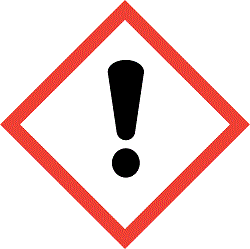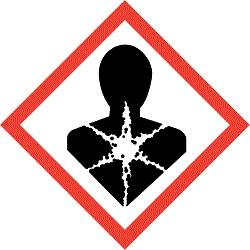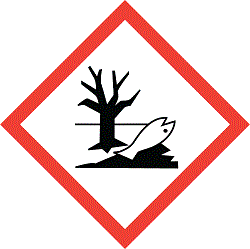
Example 9
The purpose of this example is to show calculation of Specific target organ toxicity - repeated exposure (STOT RE) according to Regulation (EC) No 1272/2008 (CLP).
There is a liquid mixture consisting of the following ingredients:
| Ingredient | Conc. % (w/w) | Classification | Specific Conc. Limits, M-factors and ATEs |
| Substance A | 3.4 |
Carc. 2: H351 STOT RE 1: H372 Skin Sens. 1: H317 |
− |
| Substance B | 11.2 |
Repr. 1B: H360F Carc. 1B: H350 STOT RE 1: H372 (respiratory and haematopoietic systems) |
− |
| Substance C | 5.7 |
Carc. 2: H351 STOT RE 2: H373 Aquatic Chronic 2: H411 |
− |
| Substance D | 0.08 |
Carc. 1B: H350 Repr. 2: H361f STOT RE 1: H372 (lung) |
STOT RE 1: H372: C ≥ 0.1 % Carc. 1B: H350: C ≥ 0.01 % STOT RE 2: H373: 0.01 % ≤ C < 0.1 % |
| Substance E | 11.5 |
STOT RE 2: H373 (kidneys) Skin Sens. 1: H317 Aquatic Acute 1: H400 Aquatic Chronic 1: H410 |
M = 1 M = 1 |
| Water | 68.12 | − | − |
Calculation of mixture classification.
Following ingredients are classified as respiratory / skin sensitisers:
| − | Substance A: Skin Sens. 1: H317. |
| − | Substance E: Skin Sens. 1: H317. |
Cut-off limits
| − | There is no generic cut-off limit for respiratory and skin sensitisation (CLP, Annex I, Table 1.1), therefore, any concentration of an ingredient with such classification is taken into account. |
Specific and Generic concentration limits
| − | Because no specific concentration limits are applied for substances A and E their concentrations should be compared to generic concentration limits. |
Calculation of 'Skin Sens. 1'
| − | Concentration of substance A is above the generic concentration limit 1.0 % (CLP, Annex I, Table 3.4.5). Because no sub-categorisation is required this leads to classification Skin Sens. 1 . |
| − | Concentration of substance E is above the generic concentration limit 1.0 % (CLP, Annex I, Table 3.4.5). Because no sub-categorisation is required this leads to classification Skin Sens. 1 . |
Selection of hazard category
| − | The mixture is classified as 'Skin Sens. 1'. |
Selection of hazard statements
| − | H317 corresponds to 'Skin Sens. 1'. |
Selection of pictogram and signal word
| − | Pictogram GHS07 and signal word 'Warning' correspond to 'Skin Sens. 1'. |
Selection of precautionary statements
| − | For H317 following precautionary statements are applied: P261, P272, P280, P302+P352, P333+P313, P321, P362+P364, P501. |
Following ingredients are classified as carcinogens:
| − | Substance A: Carc. 2: H351. |
| − | Substance B: Carc. 1B: H350. |
| − | Substance C: Carc. 2: H351. |
| − | Substance D: Carc. 1B: H350. |
Cut-off limits
| − | There is no generic cut-off limit for carcinogenicity (CLP, Annex I, Table 1.1), therefore, any concentration of an ingredient with such classification is taken into account. |
Specific and Generic concentration limits
| − | Substance D has specific concentration limit (SCL). Because SCL has a precedence over generic concentration limit, concentration of D must be compared to its SCL. |
| − | Because no specific concentration limits are applied for substances A, B and C, their concentrations must be compared to generic concentration limits. |
Calculation of 'Carc. 1B'
| − | Concentration of substance D is above its specific concentration limit 0.01 %. This leads to classification Carc. 1B . |
| − | Concentration of substance B is above the generic concentration limit 0.1 % (CLP, Annex I, Table 3.6.2). This leads to classification Carc. 1B . |
Calculation of 'Carc. 2'
| − | Concentration of substance A is above the generic concentration limit 1.0 % (CLP, Annex I, Table 3.6.2). This leads to classification Carc. 2 . |
| − | Concentration of substance C is above the generic concentration limit 1.0 % (CLP, Annex I, Table 3.6.2). This leads to classification Carc. 2 . |
Selection of hazard category
| − | Classification sub-category 'Carc. 1B' is more severe than 'Carc. 2', therefore, mixture is classified as 'Carc. 1B'. |
Selection of hazard statements
| − | H350 corresponds to 'Carc. 1B'. |
Selection of pictogram and signal word
| − | Pictogram GHS08 and signal word 'Danger' correspond to 'Carc. 1B'. |
Selection of precautionary statements
| − | For H350 following precautionary statements are applied: P201, P202, P280, P308+P313, P405, P501. |
Following ingredients are classified as reproductive toxicants:
| − | Substance B: Repr. 1B: H360F. |
| − | Substance D: Repr. 2: H361f. |
Cut-off limits
| − | There is no generic cut-off limit for reproductive toxicity (CLP, Annex I, Table 1.1), therefore, any concentration of an ingredient with such classification is taken into account. |
Specific and Generic concentration limits
| − | Because no specific concentration limits are applied to substances B and D their concentrations should be compared to generic concentration limits. |
Calculation of 'Repr. 1B'
| − | Concentration of substance B is above the generic concentration limit 0.3 % (CLP, Annex I, Table 3.7.2). This leads to classification Repr. 1B . |
Calculation of 'Repr. 2'
| − | Concentration of substance D is below the generic concentration limit 3.0 % (CLP, Annex I, Table 3.7.2). This does not lead to classification 'Repr. 2'. |
Selection of hazard category
| − | The mixture is classified as 'Repr. 1B'. |
Selection of hazard statements
| − | H360F is selected for category 'Repr. 1B' because of the substance B. |
Selection of pictogram and signal word
| − | Pictogram GHS08 and signal word 'Danger' correspond to 'Repr. 1B'. |
Selection of precautionary statements
| − | For H360F following precautionary statements are applied: P201, P202, P280, P308+P313, P405, P501. |
Following ingredients are classified as specific target organ toxicity – repeated exposure (STOT RE):
| − | Substance A: STOT RE 1: H372. |
| − | Substance B: STOT RE 1: H372 (respiratory and haematopoietic systems). |
| − | Substance C: STOT RE 2: H373. |
| − | Substance D: STOT RE 1: H372 (lung). |
| − | Substance E: STOT RE 2: H373 (kidneys). |
Cut-off limits
| − | There is no generic cut-off limit for STOT RE (CLP, Annex I, Table 1.1), therefore, any concentration of an ingredient with such classification is taken into account. |
Specific and Generic concentration limits
| − | Because no specific concentration limits are applied for substances A, B, C and E, their concentrations must be compared to generic concentration limits. |
| − | Substance D has two specific concentration limits (SCLs). Because SCL has a precedence over generic concentration limit, concentration of D must be compared to its SCLs. |
Calculation of 'STOT RE 1'
| − | Concentration of substance A is below the generic concentration limit 10 % (CLP, Annex I, Table 3.9.4). This does not lead to classification 'STOT RE 1'. |
| − | Concentration of substance B is above the generic concentration limit 10 % (CLP, Annex I, Table 3.9.4). This leads to classification STOT RE 1 . |
| − | Concentration of substance D is below its specific concentration limit 0.1 % for 'STOT RE 1'. This does not lead to classification 'STOT RE 1'. |
Calculation of 'STOT RE 2'
| − | Concentration of substance A is between 1 % and 10 % of the generic concentration limit (CLP, Annex I, Table 3.9.4). This leads to classification STOT RE 2 . |
| − | Concentration of substance C is below the generic concentration limit 10 % (CLP, Annex I, Table 3.9.4). This does not lead to classification 'STOT RE 2'. |
| − | Concentration of substance D is between 0.01 % and 0.1 % of its specific concentration limit for 'STOT RE 2'. This leads to classification STOT RE 2 . |
| − | Concentration of substance E is above the generic concentration limit 10 % (CLP, Annex I, Table 3.9.4). This leads to classification STOT RE 2 . |
Selection of hazard category
| − | Classification category 'STOT RE 1' is more severe than 'STOT RE 2', therefore, mixture is classified as 'STOT RE 1'. |
Selection of hazard statements
| − | H372 corresponds to 'STOT RE 1'. |
| − | For mixtures there is no need to identify the target organs and routes of exposure on the label. |
Selection of pictogram and signal word
| − | Pictogram GHS08 and signal word 'Danger' correspond to 'STOT RE 1'. |
Selection of precautionary statements
| − | For H372 following precautionary statements are applied: P260, P264, P270, P314, P501. |
Following ingredients are classified as hazardous to the aquatic environment:
| − | Substance C: Aquatic Chronic 2: H411. |
| − | Substance E: Aquatic Acute 1: H400 / Aquatic Chronic 1: H410. |
Cut-off limits
For 'Aquatic Acute 1' and 'Aquatic Chronic 1' cut-off limit is calculated according to formula 0.1/M (CLP, Annex I, 4.1.3.1), where M is M-factor.
| − | There is no M-factor in Table 3 of Annex VI to CLP established for substance E. Person responsible for classification decided to use M = 1 for both 'Aquatic Acute 1' and 'Aquatic Chronic 1'. Concentration of substance E is above 0.1 % (0.1/1), therefore, it is taken into account for calculation of both 'Aquatic Acute 1' and 'Aquatic Chronic 1'. |
For Aquatic Chronic categories 2-4 the generic cut-off limit 1 % is applied (CLP, Annex I, Table 1.1):
| − | Concentration of substance C is above 1 %, therefore, it is taken into account for calculation of 'Aquatic Chronic 2'. |
Specific and Generic concentration limits
Neither specific nor generic concentration limits are applied for acute toxicity.
Calculation of 'Aquatic Acute 1'
| − | Concentration of substance E must be multiplied by its M-factor.
conc. E × M = 11.5 × 1 = 11.5 The obtained value is below 25 % (CLP, Annex I, 4.1.3.5.5.3.1 and Table 4.1.1). This does not lead to classification 'Aquatic Acute 1'. |
Calculation of 'Aquatic Chronic 1'
| − | Concentration of substance E must be multiplied by its M-factor.
conc. E × M = 11.5 × 1 = 11.5 The obtained value is below 25 % (CLP, Annex I, 4.1.3.5.5.3.1 and Table 4.1.1). This does not lead to classification 'Aquatic Chronic 1'. |
Calculation of 'Aquatic Chronic 2'
| − | Concentration of substance E must be multiplied by its M-factor and multiplied by 10. Obtained value must later be summed with concentration of substance C.
(M × 10 × conc. E) + conc. C = (1 × 10 × 11.5) + 5.7 = 120.7 The obtained value is above 25 %. This leads to classification Aquatic Chronic 2 . |
Selection of hazard category
| − | The mixture is classified as 'Aquatic Chronic 2'. |
Selection of hazard statements
| − | H411 corresponds to 'Aquatic Chronic 2'. |
Selection of pictogram and signal word
| − | Pictogram GHS09 corresponds to 'Aquatic Chronic 2'. No signal word applies. |
Selection of precautionary statements
| − | For H411 following precautionary statements are applied: P273, P391, P501. |
signal word and P statements
| Classification categories | Classification | H statements | Pictograms | Signal words | P statements |
| Respiratory / Skin sensitisation | Skin Sens. 1 | H317 |  GHS07 |
Warning | P261, P272, P280, P302+P352, P333+P313, P321, P362+P364, P501 |
| Carcinogenicity | Carc. 1B | H350 |  GHS08 |
Danger | P201, P202, P280, P308+P313, P405, P501 |
| Reproductive toxicity | Repr. 1B | H360F |  GHS08 |
Danger | P201, P202, P280, P308+P313, P405, P501 |
| Specific target organ toxicity - repeated exposure | STOT RE 1 | H372 |  GHS08 |
Danger | P260, P264, P270, P314, P501 |
| Hazardous to the aquatic environment | Aquatic Chronic 2 | H411 |  GHS09 |
− | P273, P391, P501 |
According to Article 20(3) of CLP if both signal words are applied, 'Danger' is used.
Classification and labelling of the mixture
| Classification: | Skin Sens. 1, Carc. 1B, Repr. 1B, STOT RE 1, Aquatic Chronic 2 |
| Hazard statements: | H317, H350, H360F, H372, H411 |
| Pictograms: |  |
| GHS07 | |
 |
|
| GHS08 | |
 |
|
| GHS09 | |
| Signal word: | Danger |
| Precautionary statements: | P201, P202, P260, P261, P264, P270, P272, P273, P280, P302+P352, P308+P313, P314, P321, P333+P313, P362+P364, P391, P405, P501 |
According to Article 28(3) of CLP if mixture has more than 6 precautionary statements, supplier should select among of them the most important 6 statements that should be indicated on the label. The same selected statements should be placed in section 2.2 'Hazards identification' of safety data sheet (SDS). The rest may be placed in section 16 'Other information' of SDS.